THE OTHER INTERESTING 8-BIT COMPUTERS
SHARP MZ
 |
The Sharp MZ-700 (on the picture) serie replaces the old MZ-80 (MZ-80K, MZ-80A and MZ-80B) serie.
Moreover, the MZ-700 is compatible with the MZ-80K. The MZ-700 serie is made up of
four models: The MZ-710 was the "naked" model, the MZ-720 had an integrated tape recorder and the MZ-730 (1983)
had an integrated plotter too. The fourth model was the MZ-780 (1985) which had a 80 columns
gfx card, a floppy drive and a Centronics port. It worked under CP/M. There was
no language in ROM, so it had to be loaded from tape. The partialy compatible successor of the MZ-780 is the MZ-800 (1985). This micro is based on Z80 CPU too, has 64 KB RAM, and an integrated tape-recorder, which can be substituted for a Quick-disk unit (2,8" disk with a sequential access). It works under a special version of CP/M called P-CP/M. |
| EMULATORS | ||
|---|---|---|
| MZ-800 Emulator 0.0050 beta | Excelent MZ-800 emulator for Windows (freeware) | MZunity |
| MZ-700win 0.52 | MZ-700 emulator for Windows 95/NT (freeware) | Author's page (in japanese) |
| MZ-800 emulator 3.10 | Excelent MZ-800/700 emulator for DOS (freeware) | MZunity |
| PROGRAM RESOURCES | |
|---|---|
| MZ Unity | ROM images |
VIDEO TECHNOLOGY LASER 200
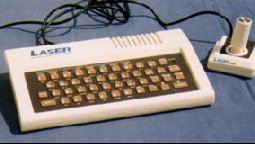 |
The Video Technology Laser 200 (aka VZ200/300, Texet TX8000 in some countries) was pretty cheap computer made in Hong Kong in 1983. It is powered by Zilog Z80 microprocesor at 3,58 MHz, it has 4 KB RAM (max. 64) and 16 KB ROM. |
| EMULATORS | ||
|---|---|---|
| VZEM 2.0 | VZ200/300 emulator for DOS (freeware) | Author's page |
| WinVZ 0.3 | VZ emulator for Windows (freeware) | Author's page |
| PROGRAM RESOURCES | |
|---|---|
| VZ Alive | ROM image |
MATTEL AQUARIUS
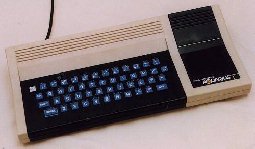 |
The Mattel Aquarius was launched in 1983. It uses a Z80 CPU and 4 KB RAM (max. 16 KB). A special peripheral called BSR X-10 was developped for this computer, it allows the Aquarius to pilot directly up to 255 electric devices. |
| EMULATORS | ||
|---|---|---|
| AqEmu 1.0 | Mattel Aquarius emulator for Windows (freeware) | Author's page |
| Virtual Aquarius 0.7 | Mattel Aquarius emulator for Windows (freeware) | Author's page |
| PROGRAM RESOURCES | |
|---|---|
| N/A | ROM image |
MEMOTECH MTX
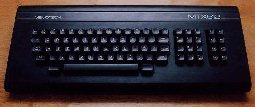 |
The Memotech MTX (1983) featured the same characteristics as the MSX computers (e.g. Z80 CPU), but it was not compatible. There are two models of MTX - the MTX 500 (32 KB) and the MTX 512 with 64 KB RAM. With floppy disk unit, the MTX 512 can run under CP/M. |
| EMULATORS | ||
|---|---|---|
| Mt. Xemu release 1 | Memotech emulator for Windows (freeware) | Author's page |
| PROGRAM RESOURCES | |
|---|---|
| Memotech World Memotech tape images |
ROM image |
MICROBEE
 |
The Microbee (1982) was based on Z80 and 8 KB RAM, and originally was available in kit-form. It came with a built-in wordprocessor, BASIC, and serial communication software. It apparently did well in the Australian schools market, but later lost out to the BBC micro. A 128KB version with twin floppy drives was released just before the company's demise in 1986. |
| EMULATORS | ||
|---|---|---|
| nanowasp 7.4.2001 | An early stage of Microbee emulator for DOS (freeware) | Author's page |
| PROGRAM RESOURCES | |
|---|---|
| N/A | ROM image |
Camputers LYNX
 |
The Lynx 48 (1983) was based on Z80 CPU and had 48 KB RAM, Lynx 96 had 96 KB RAM. It was manufactured by british company Camputers, and intended to be a competitor of the Sinclair Spectrum and the Oric-1, but did not live long. The Lynx 128 (1984) is the successor of the Lynx 48. It was sold with the Microsoft Basic, and could run under Lynx DOS and CP/M 2.2. |
| EMULATORS | ||
|---|---|---|
| CamLynx | Lynx emulator for DOS (freeware) | Lynx on emu-france |
| Pale 1.5 | Lynx emulator for Windows (freeware) | Author's page |
| PROGRAM RESOURCES | |
|---|---|
| Games | ROM: integrated into the emulator |
DELTA
 |
The DELTA is a genuine Sinclair ZX-Spectrum + which was sold and exported from former Yugoslavia. As I believe, they bought the unsold stock from bankrupting Sinclair Research. They removed any references revealing machine's origin: a) original Sinclair logo was disguised with a thin plastic plate with the word DELTA, b) a spectrum symbol on the right side of the machine was also removed, c) and a "Made in United Kingdom" sticker was there to cover the copyright on the lower side. |
| EMULATORS |
|---|
| Emulators see the Sinclair section |
EXIDY SORCERER
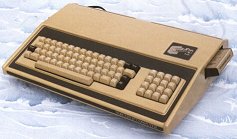 |
Sorcerer was made on 1978 by american company Exidy Inc. as an competition for Apple II and Commodore PET. (On 1980 Sorcerer II followed.) It was based on Z80/2 Mhz CPU and featured 8-48 KB RAM. Graphic resolution was 512 x 240, text 64 x 30/mono. It used either floppy, tape (1200 bps) or ROM packs for loading the software. |
| EMULATORS | ||
|---|---|---|
| Windows Sorcerer 0.01 | Exidy Sorcerer emulator for Windows (freeware) | Author's page |
| PROGRAM RESOURCES | |
|---|---|
| N/A | ROM image |
TESLA PMD-85
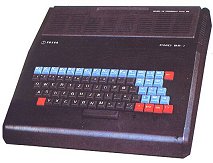 |
The PMD-85 (1985) was a czechoslovakian micro, based on MHB 8080A/2 MHz CPU, manufactured by slovakian company Tesla Bratislava. It featured 4 KB ROM and 48 KB RAM, 288 x 256 of graphic and 48 x 25 of text resolution, 4 colors and 1 sound channel. A following verions were available: PMD-85-1 (most common), PMD-85-2 (better keyboard and software), PMD-85-2A (new motherboard), PMD-85-3 (new motherboard again), Mato (kit of a clone in a smaller case). This machine was well known among kids and fans for its presence in schools in 80's. |
| EMULATORS | ||
|---|---|---|
| PMD-85 (P. Chrenko) | PMD-85 emulator for DOS (freeware) | Author's page |
| PMD-85 (M. Schotek) | PMD-85 emulator for DOS (freeware) | Author's page |
| PMD-85 pro Windows 8.8.2001 (M. Schotek) | PMD-85 emulator for Windows (freeware) | Author's page |
| PROGRAM RESOURCES | |
|---|---|
| Downloady od Schotka | ROM: integrated into emulator |
SORD M5
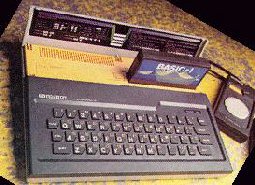 |
The SORD M5 (1982) had no really great success outside Japan, but had lot of interesting characteristics. It uses Z80 microprocessor, 4 (max. 32) KB RAM, and has the same video characteristics as the MSX computers (but doesn't belong to this family). It was sold with a ROM cardridge, containing three Basic languages: the Basic-I (very simple version for beginners), the Basic-G (with lot of graphic commands) and the Basic-F (for mathematic and scientific applications). |
| EMULATORS | ||
|---|---|---|
| SORD-M5 emulator 1.0 | BASIC-I cartridge SORD-M5 emulator for DOS (freeware) | SORD on emu-france |
| PROGRAM RESOURCES | |
|---|---|
| N/A | ROM image |
SEGA COMPUTER 3000
 |
SEGA Computer 3000 (1983) is a computer version of the SEGA's SG-1000 game console. It was built around the NEC D780C-1/3,58 MHz processor (Z80 clone) and exchangeable ROM/RAM cartridges. Machine offered graphics resolution 256x192 (16 colors) and the sound chip with 3 sound channels and 1 noise generator (6 voices). |
| EMULATORS | ||
|---|---|---|
| SC3K 1.43 | SEGA Computer 3000 emulator for Windows (freeware) | SC3K on emu-france |
| PROGRAM RESOURCES | |
|---|---|
| N/A | ROM: integrated into the emulator |
(EMULATORS NOT AVAILABLE)
IQ-151
 |
The IQ-151 was a czechoslovakian school micro manufactured by ZPA Novy Bor. It featured MHB 8080A processor, 32 KB RAM and 4 KB ROM, B&W text display 32(64) x 32. The standard peripheral was only the cassette player but with a special modules was also possible to connect a printer, plotter and the other peripherals. A most common modules was: VIDEO [display], BASIC [interpreter], BASIC G [graphic Basic interpreter], GRAFIK [256 x 512 graphics], STAPER [printer], MINIGRAF [plotter]. IQ-151 featured 5 expansion slots for these modules. |
ONDRA
| Picture not available 8-( | Developed in Elstroj and produced by Tesla Liberec and leter Tesla Blatna, Ondra presents probably the most promissing czechoslovakian home/school micro of 80's. It was build around U880 processor (East Germany version of Z80), 64 KB RAM and 4 KB ROM, 320 x 255 graphic display. The only peripherals possible to connect was the cassette player and the Centronics printer. (Btw TESLA has - officialy - nothing to do with famous electrician Nikola Tesla, it stands for TEchnika SLAboprouda [Light current technics].) |
PP-01
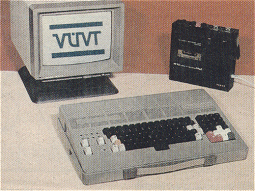 |
This 8-bit microcomputer was produced in former Czechoslovakia by ZAVT (Zavody automatizace a vypocetni techniky). It featured MHB 8080 processor and 64 KB RAM (24 KB reserved for display), 256 x 256 graphic resolution and 8 colors. The black-and-white TV or a color monitor could be attached (strange enough, not a color TV). The standard cassette player was used as the data storage device and a graphic oriented basic G/Basic was supplied with the machine. |
HANIMEX
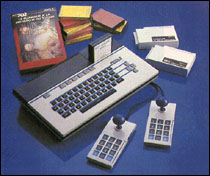 |
Hanimex Pencil II (1983) - this australian computer was built in Hong Kong by Soundic Electronics. It used Z80 microprocessor and 18 KB RAM (max. 82 KB). |
PHILIPS VG 5000
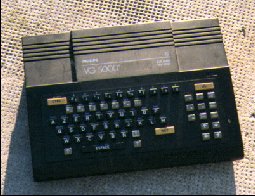 |
The Philips VG 5000 was created in 1983 - by a french company called RTC - as a cheap computer for beginers. It runs on Z80 CPU, 24 KB RAM (max. 56) and is not compatible with the other Philips VG computers. It uses Basic from Microsoft. |